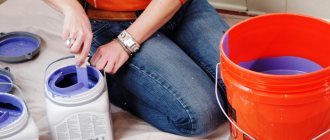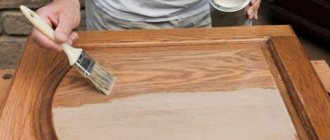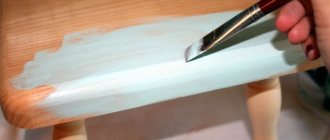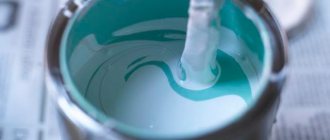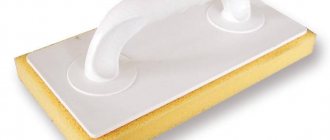You want to carry out any finishing work as quickly as possible so that the car or room acquires an attractive appearance and can be used for its intended purpose. That is why today, less and less home craftsmen take up brushes and rollers, and prefer painting with a spray gun. This technology allows you to get a perfectly even and smooth coating in a matter of minutes, while spending a minimum of effort. But in order for the result to meet expectations, you will have to follow certain rules. For example, correctly determine which paint is suitable for the spray gun in your case, and how to dilute it correctly. You will learn about this from this article.
Why do you need to dilute paint correctly?
Anyone who wants to use this tool during finishing work should know how to dilute paint for a spray gun.
You need to find out all the information and use it correctly for the following reasons:
- Too viscous, thick paint is difficult to evenly distribute in a thin layer over the desired surface. Increasing the thickness of the layer will entail an extension of the drying time and excessive consumption of material.
- When treating vertical or inclined surfaces with too thick or thin paint, unsightly smudges form, which can only be corrected by new painting.
- Most models of spray guns, especially inexpensive ones, cannot handle thick paint. The internal parts will become clogged, and the flow will either be uneven or paint will not flow out of the device at all.
- Too viscous paint, even with careful surface preparation, will not fill small irregularities, roughness, and microcracks. As a result, the coating will not be even, and over time, corrosion may form in surface imperfections, dust and debris may accumulate.
- Too diluted, liquid paint will not give the desired external effect. You will have to paint in many layers, and as a result, the coating will not be as durable as you would like, and you will have to spend much more time painting.
Important! The paint for the spray gun must be of appropriate quality, no matter how expensive or cheap the model of the tool you purchased. With this approach, if you follow the painting technology, you will in any case be able to realize your idea and paint the desired surface with high quality.
How to use a viscometer
Before thinning spray paint, you should measure the viscosity. The scheme of working with the device is as follows.
First of all, fix the measuring device in a vertical position. Place clean cups under it - one glass is enough. The container must have a volume of more than 100 ml. Then the drain hole in the device is closed and paint is poured flush around the edges. Next, the paint and varnish material is allowed to settle and after that the drain hole is opened.
You must remember to turn on the stopwatch at this moment. The end of the measurement will be when the paint stops flowing and starts dripping. The time is recorded on a stopwatch - this is also the network’s conditional viscosity data. For example, water has a viscosity of 13 sec.
The required viscosity for a high-quality result is always indicated by the manufacturer on the packaging. However, other factors may also influence the value. This is the air temperature as well as the humidity level. If the packaging does not contain any data on the consistency of the paintwork material, then the following indicators can be used:
- The viscosity level of enamels for painting metal cars should be 15-20 seconds;
- Oil enamels and oil-based dyes should have a level of 15-25 seconds;
- The viscosity of the primers should be from 15 to 30 sec;
- Varnishes are diluted to 18-20 seconds;
- Latex paints can have a viscosity of 35 to 45 sec.
If it is impossible to carry out measurements using special instruments, then it is determined visually. So, the paint should resemble thick milk.
You can obtain the correct level of paint viscosity for a spray gun by adding solvents, which are selected depending on the type of paintwork material.
What paints are suitable for a spray gun?
The modern paint and varnish market offers a wide range of finishing solutions. Many of them can be safely taken for refilling a spray gun. The following paint compositions are ideal for this purpose:
- alkyd;
- acrylic;
- water-based;
- oil;
- nitro enamels.
Important! Determine which paint for an electric spray gun you prefer based on what exactly you are going to paint:
- for wooden surfaces, oil or acrylic solutions are best suited;
- for a car - nitro enamels or alkyd mixtures;
- Water-based, acrylic and alkyd compositions are often used for wall finishing.
The main selection criteria are the expected result of strength, resistance to adverse effects, durability, attractiveness, and, of course, the cost of the paint itself.
When to dilute
A composition whose component is water is called a water emulsion. If you apply the solution to the surface, you will notice that almost all the liquid quickly evaporates. The material gets its properties thanks to special fillers, which create a painted surface.
The protective layer can be obtained after a short period of time, after complete drying. The duration of this process also depends on the material on which it is applied.
Modern hardware stores offer a wide range of water-based paints. When choosing, it is better to focus on brands of well-known manufacturers who value their name and ensure the quality of their products.
Thick paint
If you opened a jar, and inside you saw a thickened composition or it was difficult to mix. In these cases, solvents must be used. But you should not overdo it, because then the composition will begin to flow, forming smudges. The protective layer will become thinner and will not be durable, and performance characteristics will sharply decrease.
Difficult to apply
Excessive density can be determined by a significant amount of the mixture that remains on the surface during painting. There are basically two methods of applying paint.
The first option is to use all kinds of brushes or construction rollers. In this case, the structure of the mixture should be sufficiently viscous. This will make it easier to manually process the ceiling or wall covering. The composition will not drain and will lay down in an even layer. If the paint is too liquid, it will be extremely difficult to apply.
The second option is spray guns or spray guns, which can be manual or electric. Using such devices, you can work even on very large areas. They will also make the whole process much easier for you and the paint will lay down perfectly evenly. A special feature of the tool is that it sprays the composition through a special nozzle under high pressure. That is why it is necessary to use a liquid consistency for devices. The dosage depends on the selected instrument model.
Violation of the shelf life
The composition will have to be diluted if the storage terms or conditions were violated. This can happen if you open a jar and then close it poorly. After a while, all dried material will be unusable. But sometimes it can be restored. To do this, you need to use special solvents, which we will discuss below. You can also dissolve the paint using PVA glue. But this is a rather expensive method.
Sometimes, after opening the can, it is discovered that the composition is very liquid. In this case, you can let it sit open for a while, without a lid, so that the excess liquid evaporates.
Adding a special hardener can also be a way out.
Paint solvents - classification
To bring the paint for the spray gun to the desired consistency, you need to choose the right solvent. To do this, if you approach the process thoroughly, determine the liquid you need according to the criteria outlined below.
Important! A simpler and less expensive option is to use special branded solvents recommended by the paint manufacturer. This way, you will definitely be able to avoid mistakes and will not have to choose the best solvent yourself in a practical way. But, be prepared for the fact that saving time and effort in this case will cause large expenses.
Component composition
Each type of paint has its own component composition, which contains a certain amount of solvent and the coloring matter itself. According to this principle, the classification of paints is carried out as follows:
- low-fill;
- medium filled;
- highly filled.
Important! It is not recommended to dilute paints of the first type with large amounts of solvent. In highly filled ones, in some cases you can add up to 30% of the solvent volume. If you are faced only with the marking of paint fullness, keep in mind that the gradation in the direction of decreasing the indicator looks like this:
- VHS;
- UHS;
- MS;
- HS;
- HD;
- L.S.
Solvent type
Another important factor when choosing a suitable solvent is its polarity. According to this criterion, only 2 types of compositions are distinguished:
- non-polar;
- polar.
Important! Since the composition of the paint and the solvent itself can contain quite a lot of substances, it is impossible to accurately determine the polarity of the composition only by one’s own intuition or by one component noted in the list. Let us also take into account the fact that not all manufacturers indicate the full composition of the mixture on the packaging, justifying this as a trade secret. Therefore, in this case, it is appropriate to choose a combination of paint and solvent exclusively by practical means or by an expensive laboratory research method. But it is unlikely that anyone will agree to go for the latter option, performing work of an exclusively one-time nature for their own needs. A simpler option is to trust the recommendations of those who have already tried various options and selected the right solvent. You will find them below in this article.
Temperature conditions during painting
When diluting paint for a spray gun, you must take into account the temperature conditions in which you will carry out the work and how soon after preparing the solution you will begin painting.
Important! In order to find out accurate data on the viscosity and hardening rate of paint, you can use a special device - a viscometer.
Learn how to use it correctly from the video instructions below.
Regarding this rule, the recommendations of experts are as follows:
- Select fast solvents if coloring will occur at temperatures below 18C.
- Normal - if the temperature is stable at 20-25 degrees.
- Slow - if it is very hot indoors or outdoors and the temperature exceeds 25C.
Important! Take into account additional nuances that relate to paint color. Shiny “metallic” or “pearl” colors are best diluted with slow solvents. Then you will be able to avoid the effect of cloudiness and uneven layers.
Useful tips for choosing a solvent
If you are in doubt about your choice, use one of the following solvents for a specific type of paint:
- Acrylic - special solvents, R-12 or R-651.
- Alkyd - R-4, xylene, toluene.
- Nitroenamel is a special solvent recommended by the paint manufacturer, or P-646.
- Water-based - ordinary distilled water, alcohol, ether are suitable for dilution.
- Oil - drying oil, oil varnish.
Important! The standard rate for dilution is from 5 to 25%. As for the consumption of the paint itself, these data are indicated on the packaging by the manufacturer himself. If paint is applied correctly with a spray gun, these values may decrease slightly.
How to measure viscosity
To determine the viscosity level of coating materials as accurately and correctly as possible, special measuring instruments are used - viscometers. The unit of measurement is DIN – second. But the problem is that accurate technologies for determining the real viscosity characteristics of liquids are quite complex, and therefore are of little use for use in a workshop or garage. Therefore, measurements are made in a unit of measurement - conditional viscosity.
How to determine this catch viscosity? This parameter comes down to measuring the time sufficient for a certain volume to flow through a hole with a certain diameter.
Among the most common viscometers are models of the DIN 4 standard. It has a hole diameter of 4 mm. According to domestic standards, it can be called VZ-4. Often, VZ-246 is used to measure viscosity, but here the device has separate nozzles with the ability to replace them - their diameters are 2, 4, 6 mm.
On video: how to determine paint viscosity.
Using a spray gun
Painting with a water-based paint or any other paint is not a complicated process. Detailed instructions for operating and setting up the tool itself are usually included in the equipment passport.
Important! Please read it carefully before starting work. Try pre-charging the tool so that you thoroughly understand how it functions.
During the dyeing procedure itself, be sure to take into account the following rules that will help you avoid technological errors and overuse of the mixture:
- Prepare the surface to be painted thoroughly - seal cracks and holes, remove construction debris, traces of rust and dust, sand the base.
- Wipe the surface with a suitable composition:
- when using acrylic or latex paint - soap and water;
- when applying oil, use white spirit.
- Wipe with a clean cloth dampened with water and wait until the surface dries.
- Protect adjacent surfaces with film, and yourself with a respirator, gloves and protective clothing.
- When painting the ceiling, gradually move from one area to another. If a lot of paint is applied to one surface area, the solution will drip down or harden in the form of smudges.
- Direct the jet strictly perpendicular to the surface, in a circular motion.
- Before applying the next layer, make sure the previous one is dry. According to standards, the technical break should be at least 6-12 hours (the time depends on the composition of the paint).
Important! To learn how to properly paint with an electric spray gun, watch this video.
Correct breeding
To dilute any paint and varnish material to the desired thickness you will need:
- special measuring container (or graduated plastic glass);
- solvent;
- hardener.
To correctly determine the components for preparing the finished enamel or varnish, you need to select the type of paint and varnish mixture. All such compositions are divided into:
- one-component (alkyds or base enamels);
- two-component (acrylic enamels, primers, varnishes).
To dilute a one-component composition, only a solvent is needed. But two-component ones require the additional use of a special hardener, which is poured into the prepared composition first.
In this case, there are no universal mixing proportions, since they are different for each material. The manufacturer's recommendations will help you choose the optimal ratio.
Basic proportions
If you are doing the work yourself and for the first time, then you may have some difficulties. It is especially difficult to calculate proportions. First of all, you need to look for specific proportions on the label, and only then test the consistency on a test plot and make adjustments if necessary.
Acrylic paint for wood: environmentally friendly and decorative surface protection
When performing renovation work in a private house, apartment or country house using natural materials, the best option for processing them is acrylic paint . This water-based composition is easy and quick to apply, reliably protects the surface from the effects of adverse factors, while simultaneously giving it a decorative appearance. You can learn about the distinctive features of paint and the rules for choosing it from this article.
Acrylic paint for wood is easy to apply and dries quickly.

